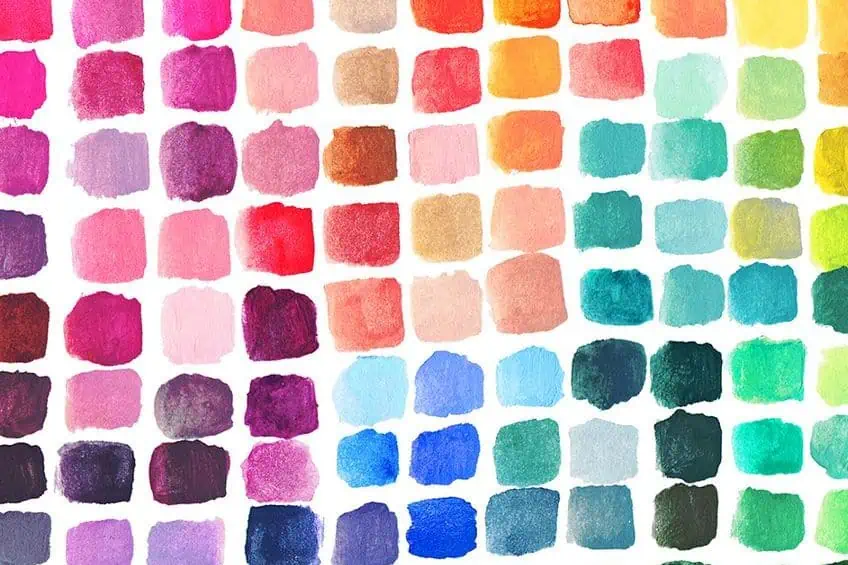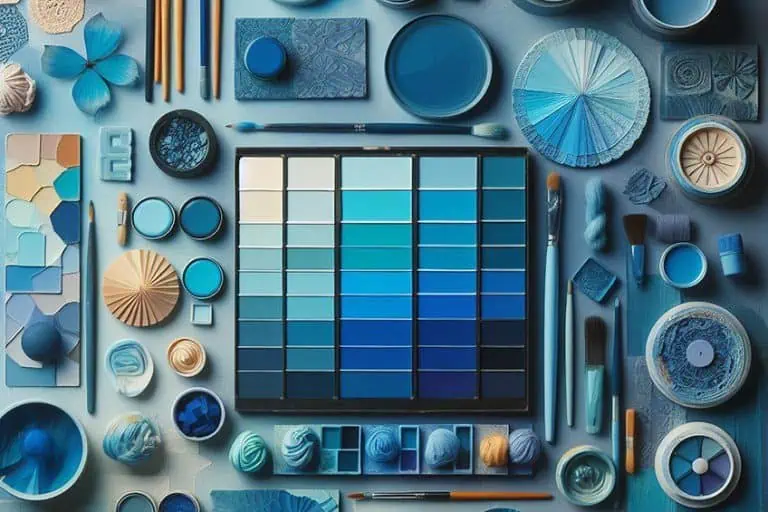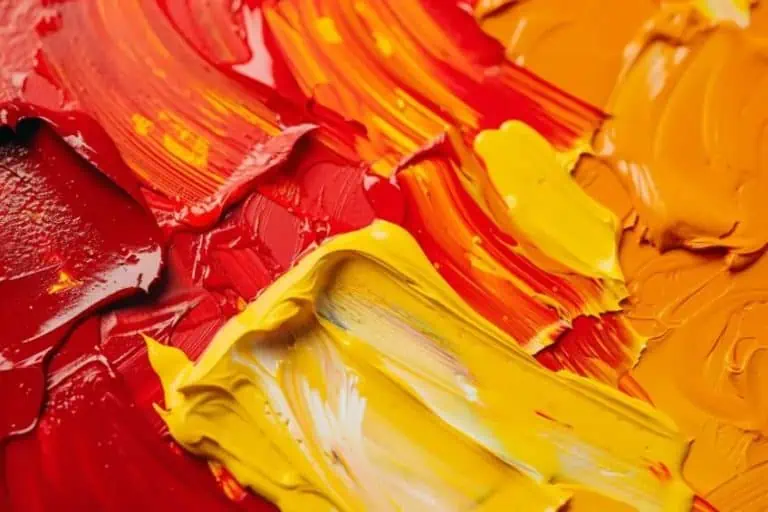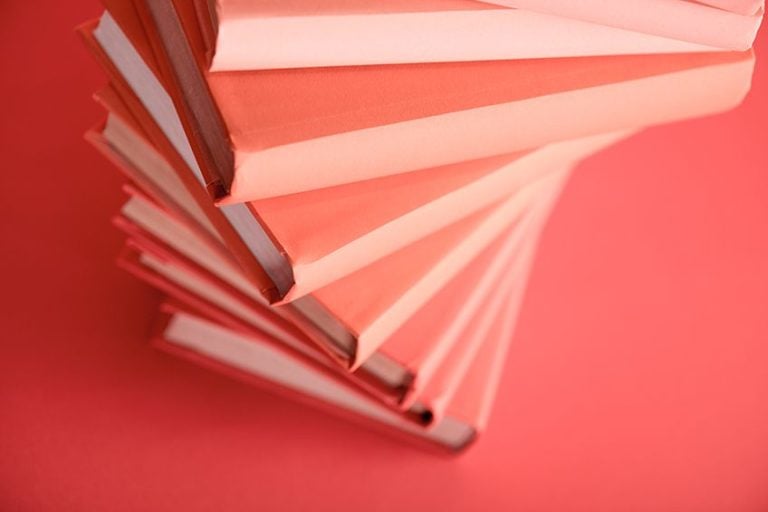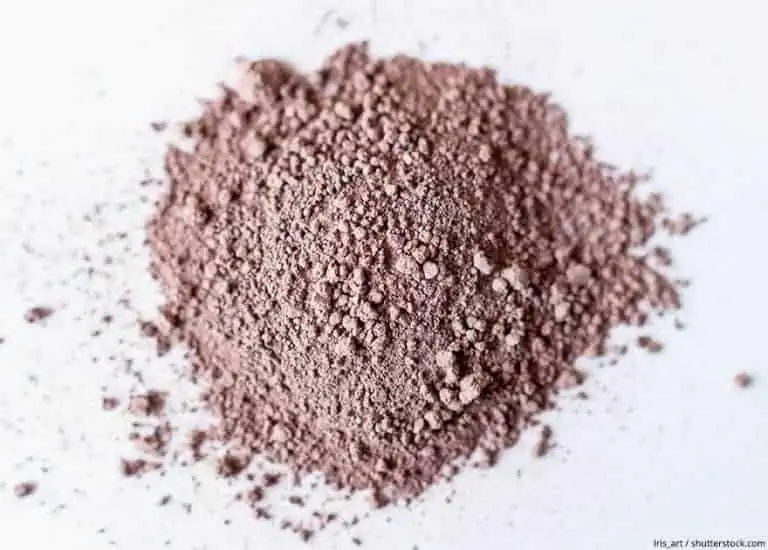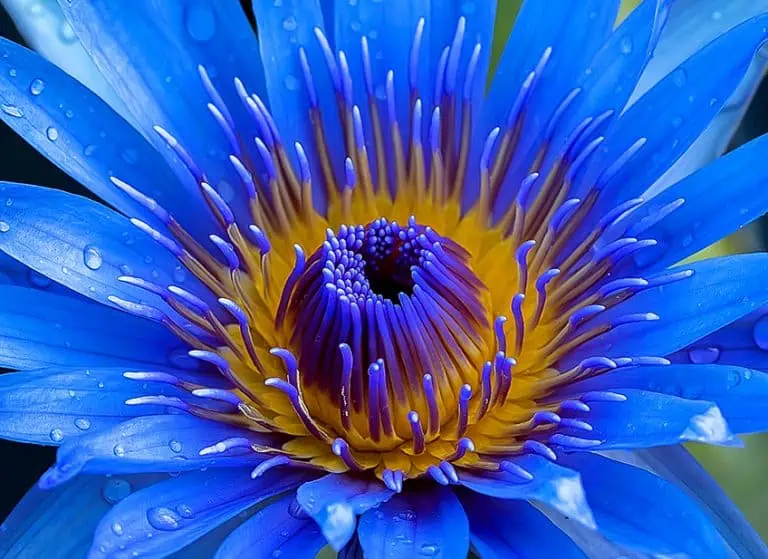Color Emotions – Colors Associated with Emotions and Moods
This post may contain affiliate links. We may earn a small commission from purchases made through them, at no additional cost to you.
Despite the portrayal of old photographs, color has and always will be all around us. It is only natural for people to form attachments and emotions towards things as we go about life and link certain events, things, or colors to emotions and experiences. Over time these colors associated with emotions became essential to companies, designers, and artists to evoke certain feelings when people perceive their brand or designs. It is important to note that color emotions are a very personal and subjective experience, and not every single person’s connection to a certain color will be the same.
Table of Contents
Color Emotion Chart
The color emotion chart below is a summary of color emotions associated with all colors. It is important to note that each color has various shades and tones, which can alter the effectiveness of each emotion. For the chart below, only true hues were used as examples.
| Color Hue | Colors | Hex Code | Shade | Color Emotions |
| Warm Colors | Red | #FF0000 | Passionate, important, aggressive, love, warmth, intensity, comfort | |
| Orange | #FFA500 | Playful, energetic, cheap, stimulating, exciting, happy, joyful, spiritual | ||
| Yellow | #FFFF00 | Happy, friendly, warning, optimism | ||
| Cool Colors | Green | #00FF00 | Natural, stable, prosperous, growth, harmony, tranquility, fertility, creativity | |
| Blue | #0000FF | Serene, trustworthy, inviting, loyalty, wisdom, calmness | ||
| Purple | #A020F0 | Luxurious, mysterious, romantic, respect, wisdom, sophistication, bravery | ||
| Pink | #FFC0CB | Feminine, young, innocent, love, calming, gentle, romance | ||
| Neutral Colors | Brown | #964B00 | Earthy, sturdy, rustic, stability, security, comfort, organic, reliability, sadness, isolation | |
| Black | #000000 | Powerful, sophisticated, edgy, sad | ||
| White | #FFFFFF | Clean, virtuous, healthy |
Grouped Color Emotions
Keeping the above color emotion chart in mind, it is important to note that color emotions can be grouped according to their shades as well. According to color theory, colors that have long wavelengths are considered warm colors, and colors that have shorter wavelengths are considered cool colors. Our eyes take longer to adjust to colors with long wavelengths/warm colors than to blue colors. Blue, purple and green are all considered cool colors. With reference to the above table, most of these cool colors have negative associations. Whereas red, orange, and yellow, all warm colors, have a lot of positive references. Thus, using only cool colors in a painting can emphasize negative emotions, and using only warm colors in a painting can in turn evoke strong positive emotions.
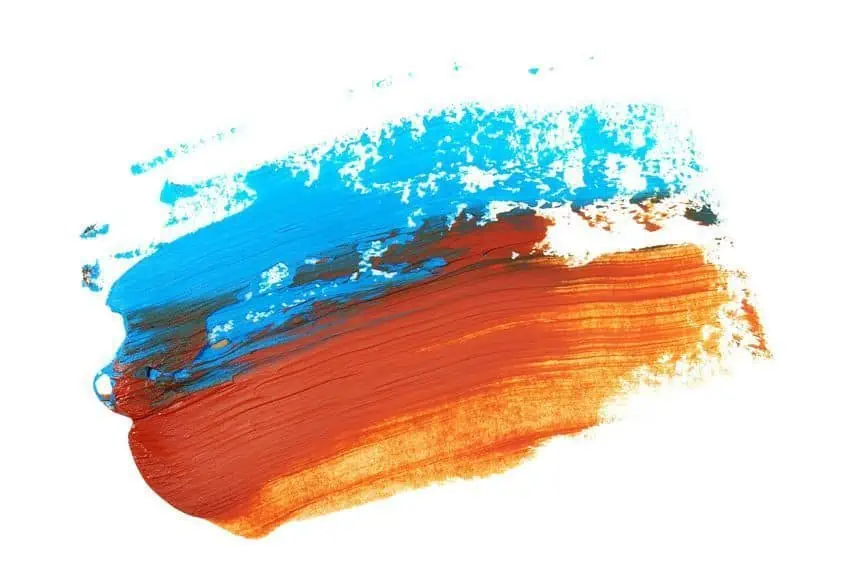
Sad Mood Colors
Colors representing emotions that are dark, cold, and muted are usually perceived as sad colors. Grey is seen as the saddest color, as it reminds us of dark clouds and storms. Other sad colors are blue, green, and neutrals like beige.
Black is also considered a sad color, as in most societies we can see that the color black is the official dress code for funerals, where it is worn as a sign of mourning and respect.
| Sad Shade | Hex Code | CMYK Color Code (%) | RGB Color Code | Color |
| Grey | #808080 | 0, 0, 0, 50 | 128, 128, 128 | |
| Dark Blue | #000066 | 100, 100, 0, 60 | 0, 0, 102 | |
| Dark Green | #006400 | 100, 0, 100, 61 | 0, 100, 0 | |
| Black | #000000 | 0, 0, 0, 100 | 0, 0, 0 |
Happy Mood Colors
Colors representing emotions that are happy, tend to be warm colors. These include bright yellow, orange, red, and pink. These colors are all reminiscent of warmth, love, and joy for most people. Neon or very bright or pastels of, otherwise sad colors can also be felt as happy. The three primary colors of blue, red, and yellow are also seen as very happy colors when used in their true form and not used in their darker shades.
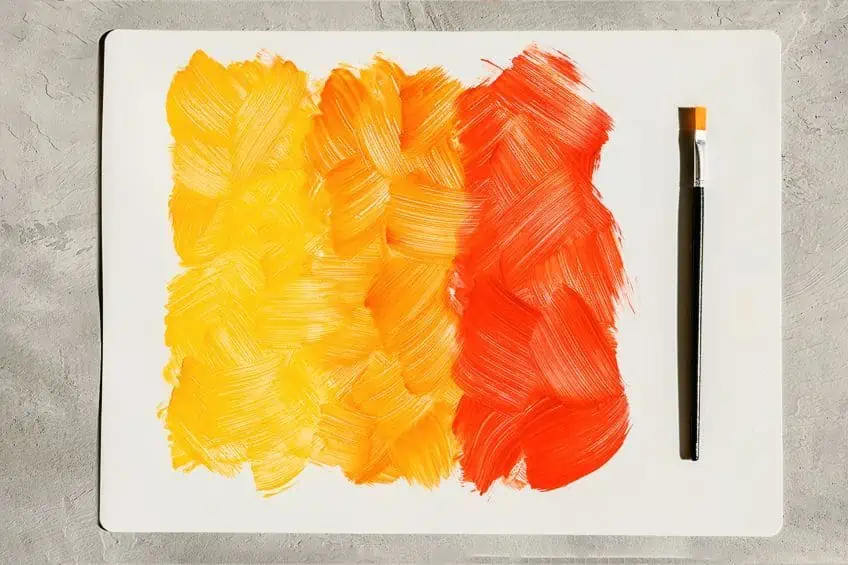
| Happy Shade | Hex Code | CMYK Color Code (%) | RGB Color Code | Color |
| Yellow | #FFFF00 | 0, 0, 100, 0 | 255, 255, 0 | |
| Orange | #FFA500 | 0, 35, 100, 0 | 255, 165, 0 | |
| Red | #FF0000 | 0, 100, 100, 0 | 255, 0, 0 | |
| Light Pink | #FFC0CB | 0, 25, 20, 0 | 255, 192, 203 |
Comforting Mood Colors
Colors associated with emotions of comfort are usually cool colors like blue, purple, and green. These colors are especially calming when lighter or pastel shades are used. Light neutrals like beige, grey, and white also emit a sense of comfort. It is important to take a less is more approach when wanting to create a sense of comfort by making use of these colors. Too many of these colors combined will water down the effect of comfort and become a bit more chaotic as the eye will be drawn everywhere.
Use these pairings in moderation.
| Comfort Shade | Hex Code | CMYK Color Code (%) | RGB Color Code | Color |
| Baby Blue | #5DAEFF | 64, 32, 0, 0 | 93, 174, 255 | |
| Lilac | #D192F8 | 16, 41, 0, 3 | 209, 146, 248 | |
| Mint Green | #94E86A | 36, 0, 54, 9 | 148, 232, 106 | |
| Beige | #F5F5DC | 0, 0, 10, 4 | 245, 245, 220 | |
| Light Grey | #808080 | 0, 0, 0, 50 | 128, 128, 128 | |
| White | #FFFFFF | 0, 0, 0, 0 | 255, 255, 255 |
Energizing Mood Colors
Bright, neon colors are all uplifting and energizing colors. Bright green, yellow and red are colors that can make you feel more aware. These colors should be used together as minimally as possible as they can be very straining on the eyes. These colors immediately grab attention from far away: Magenta, turquoise, royal blue, electric yellow, and neon green.
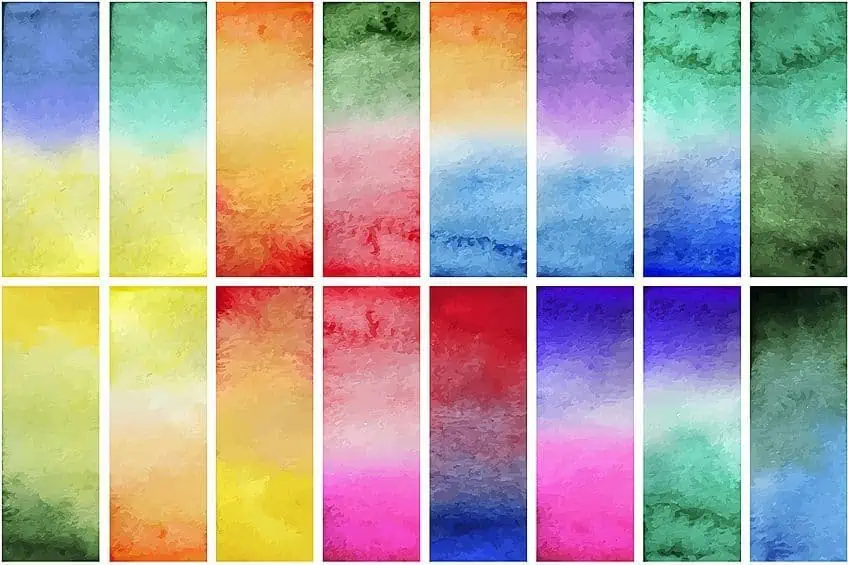
| Energizing Shade | Hex Code | CMYK Color Code (%) | RGB Color Code | Color |
| Magenta | #FF00FF | 0, 100, 0, 0 | 255, 0, 255 | |
| Turquoise | #30D5C8 | 77, 0, 6, 16 | 48, 213, 200 | |
| Royal Blue | #4169E1 | 71, 53, 0, 12 | 65, 105, 225 | |
| Electric Yellow | #FFF309 | 0, 5, 96, 0 | 255, 243, 9 | |
| Neon Green | #61FF47 | 62, 0, 72, 0 | 97, 255, 71 |
Individual Color Emotions
Aside from the emotional color grouping above, each individual color has its own meaning and attached emotion. It is also possible for different shades of one color to have separate meanings that either relate somewhat to the true hue or are completely the opposite.
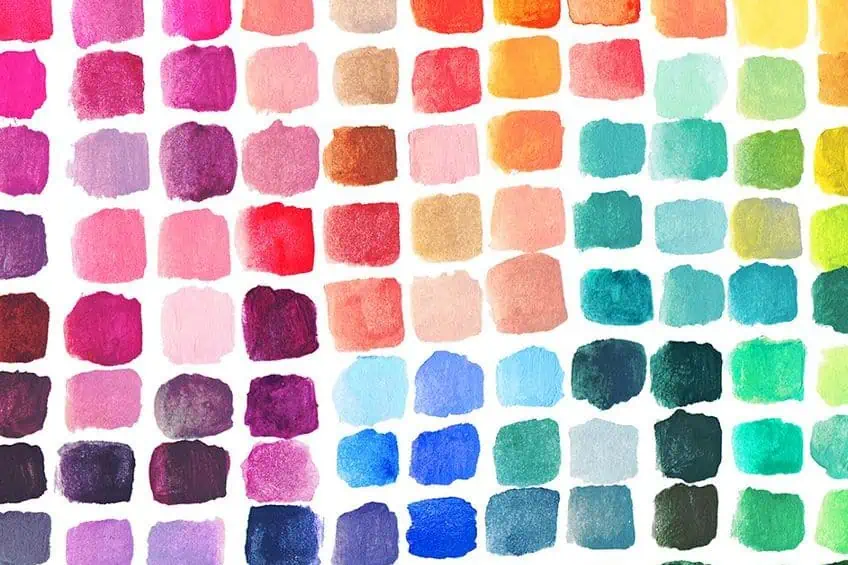
Red
Red is the color of love, anger, and passion. Red has both very positive connotations as well as very negative connotations – there is not an in-between for the color red. The images bought up by the mind when one thinks of red are that of stop signs, the heart, blood, and fire.
Theoretically, red is one of the most visible colors in the entire color spectrum because of its long wavelength.
For this reason, red is used universally as a sign of danger or a way to alert people. These examples are evident in sirens, fire engines, traffic lights, and stop signs. Red is also a vital way of communication in the English language, as we can hear in phrases like “that is a red flag” or “my finances are in the red”. It is mostly used to express negative statements. Red is also a symbol of power, class, and importance, which is why a red carpet is used at high-end events for celebrities and notables.

Color emotions aside, red is known to physically alter the state of a person’s wellbeing, like enhancing the metabolism, raising blood pressure, and increasing the heart rate as well as the respiration rate. There is also the more known fact about red, that it stimulates the appetite, which is why it is such a popular color choice for restaurants all over the world.
| Red Shade | Red Hex Code | Color | Color Emotion |
| Peach | #FF5353 | Youthfulness, Femininity | |
| Red | #FF0000 | Youthfulness, Playfulness | |
| Maroon | #D60000 | Power, Durability, Importance |
Orange
Orange is a secondary color that shares the characteristics and emotions of both red and yellow. Orange is thus the perfect combination of love, passion, happiness, and optimism. Orange is a prime example of how cultural differences come into play when associating emotions and symbols with certain colors. In the United States, orange is associated most with prison uniforms and Halloween, whereas in other countries it is associated with spirituality, like in Southeast Asia where we see Buddhist monks draped in orange robes to signify simplicity. This tradition stemmed from unwanted clothes being dyed using spices such as saffron and turmeric.
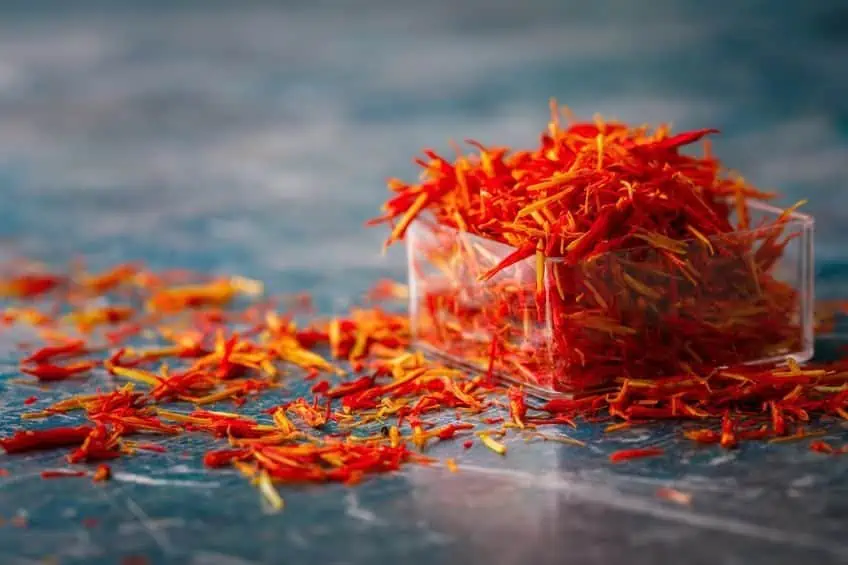
Being a darker shade of yellow, or orange is very attention-grabbing without being too distracting. This is why we see orange used as road signs and equipment such as cones. Signifies vitality, health vibrance, and energy. We can see a lot of orange branding in sports uniforms as well as gaming companies, where the above-mentioned characteristics are reflected.
| Orange Shade | Orange Hex Code | Color | Color Emotion |
| Vivid Orange | #FF5E0E | Energy, Vivaciousness | |
| Pumpkin | #F5761A | Warmth, Coziness |
Yellow
Ever wondered what color means happiness? Yellow is mostly known to be a very happy color. Most people believe that yellow is a positive color, as it reminds us of the warm sun and bright sunflowers. It evokes vitality, energy, optimism, and light when used strategically and in certain shades. Overuse of an overly bright yellow can be very distracting and straining on the eyes and can even cause anxiety and irritability.

Yellow is also seen as a very gender-neutral color, which is the reason why the pastel version of yellow became such a popular color to use in babies’ rooms. Being one of the primary colors, it can be very overwhelming when used in its true form but works great as a pop of color to grab attention. Therefore, yellow is often used on advertisements, and traffic signs, as well as the main color choice for taxis. Ever wondered why post-it notes are mostly yellow? Yellow resonates most with the intellectual left brain that oversees organizing, list-making, and note-taking.
| Yellow Shade | Yellow Hex Code | Color | Color Emotion |
| Bright Yellow | #FFFF00 | Obnoxious, Happy, Anxious, Warning | |
| Pastel Yellow | #FFFFB7 | Happy, Content, Organized |
Green
A lot of people find an association with green because it is such a natural color that appears all over nature. The fact that it is so evident in nature is clear when emotions like harmony and balance are perceived when looking at green. Although technically a cool color with a short wavelength, green sits right in between the extremely warm and extremely cool colors on the color wheel, and this further emphasizes the balance of green. The word green has also been adapted to mean sustainability and eco-friendliness. Environmentalist companies use this in their “going green” slogans. Placing even more emphasis on the natural aspect of green, it is also seen as a healing color that can relieve stress, and in some cultures, it also represents fertility. In western culture, it is also a representation of financial security and money.
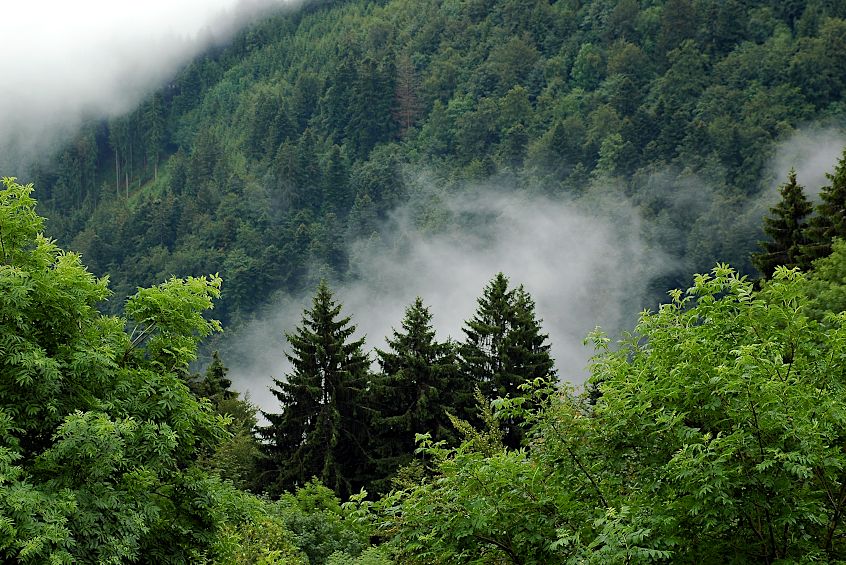
We also give the “green light” when meaning to go ahead or continue with something, because it is seen as safe to do so when the color green is displayed. Speaking of light, studies have shown that reading a green light improves overall reading abilities, whereas red, being the opposite of red, decreases reading ability. Although the positives are many, green does have some negative associations: Green is also seen as the color of envy, hence the metaphor “green with envy”. Another negative connotation of green is that it symbolizes sickness in some cases, where the term “turning green” is referred to.
| Green Shade | Green Hex Code | Color | Color Emotion |
| Forest Green | #0B6623 | Peaceful, Grounded, Nature | |
| Lime Green | #C7EA46 | Jealousy, Coolness |
Blue
Blue is trustworthy, serene, calm, and wise. Just like pink is perceived as a feminine color, blue is seen as the opposite of pink. This means that, although an outdated notion, blue is perceived as a masculine color. Being a very cool color on the color wheel, blue is also seen as a sad color. Think of Picasso’s “blue period” paintings, which all evoke sadness and loneliness. Blue is the most favored color of all colors, and that is why we see shades like navy blue in business and school uniforms all over the world. It is seen as a very professional color that evokes trust, which is why blue can be seen as a popular color used by banks. Blue is also a color with popular sayings in the English language. Some examples are blue Monday, blue moon, the blues, and blue blood.

Just like red raises the heart rate and body temperature, blue does the opposite by lowering pulse rate and body temperature. Placing even more emphasis on the stark contrast that blue is to red, blue is known to be an appetite suppressant, which makes blue very unpopular in restaurant branding and design, aside from seafood restaurants, of course. Although a primary color, blue is also seen as a natural color, as it is the color that covers over 70 percent of the earth. The ocean itself with all its shades of blue, alone is a symbol of life, stability, power, strength, and calm. The natural aspect of blue is also emphasized when we look up at the sky and see never-ending blue on a clear day. There are many different variations and shades of blue, and every shade seems to have a different emotion attached to it.
| Blue Shade | Blue Hex Code | Color | Color Emotion |
| Baby Blue | #5DAEFF | Comfort, Serenity, Peace | |
| Turquoise | #30D5C8 | Energetic, Serenity, Free, Refreshing | |
| Royal Blue | #4169E1 | Energetic | |
| Navy Blue | #000080 | Sadness, Trustworthy, Dependability, Security |
Purple
Purple is the color of luxury, royalty, and spirituality. Derived from blue and red, it is a very rich color that seems to combine the qualities of blue’s comfort and red’s appetite stimulant. This might be the reason we see purple used by a lot of chocolate brands like Cadbury and Wonka, which emphasizes the luxurious character of the color. Used in its true form it is very strong and prominent, but lighter lilac shades are very comforting colors Purple is also a more creative color than it is intellectual. It is a very different and bold color choice when chosen for anything, from interiors to artwork, to fashion.
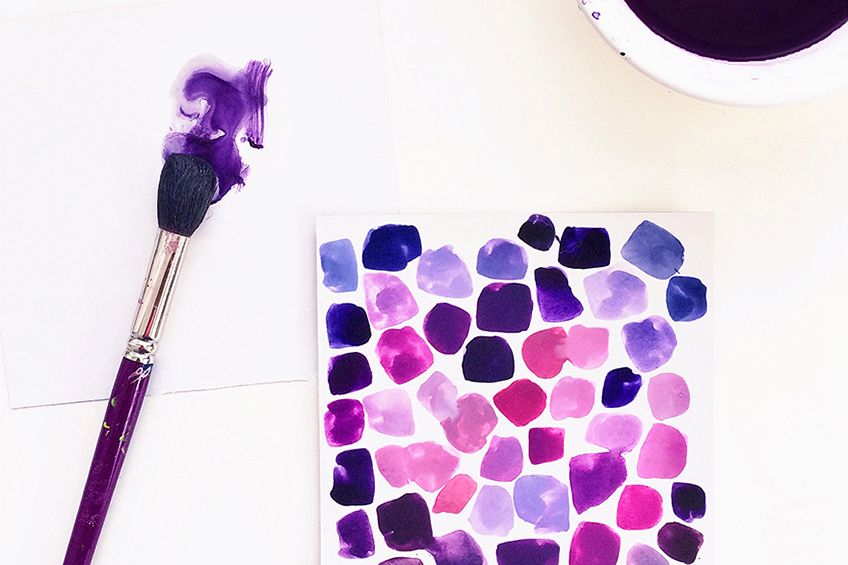
Historically, purple dye was rare and expensive because purple is a less common color in nature. The rarity of the color purple made it a symbol of extravagance, and the connotation pulls through to this day. Purple is the choice of color for royals like Queen Elizabeth II on her robe when she was on her way to her coronation in 1953. Purple is linked to wealth, the unknown, and the divine. As with blue, the answer to the question of what mood is purple differs depending on the purple hue. Although mostly a positive and light color, some parts of Europe perceive purple as the color of death and mourning.
| Purple Shade | Purple Hex Code | Color | Color Emotion |
| Dark Purple | #4B0082 | Sadness, Frustration, Creativity, Sensual | |
| Purple | #A020F0 | Comfort, Serenity, Peace, Spirituality | |
| Light Purple | #D192F8 | Light-hearted, Romantic |
Pink
Pink mainly consists of white, with the tiniest bit of red added. The more red you add, the darker the pink becomes until it eventually switches over to red. We can thus see pink as a very light shade of red. Sometimes a bit of blue is also added to the mix to create a more cool pink.

Pink is widely associated with femininity. We see this in most gender reveal parties, where pink balloons are released, and everyone immediately makes the association that a baby girl is to be born. Other associations stem from the femininity of pinks, such as compassion, kindness, and softness. Although considered a gender stereotype nowadays, companies still use the color pink successfully to entice the female market. There are many different varieties of pink, and each shade and tone can evoke different emotions:
| Pink Shade | Pink Hex Code | Color | Color Emotion |
| Hot Pink | #FF43A1 | Joyful, Playful | |
| Muted Pink | #FF9FCF | Youth, Innocence | |
| Dirty Pink | #D66C8D | Sophisticated, Nostalgic, Romantic |
Brown
Brown is one of those colors that have a lot of controversy around it. It has both very positive as well as very negative associations. As with most dark colors, brown is known to be one of the least favorable colors when people are asked what their favorite color is. This might be because people also tend to associate the color brown with isolation and sadness.
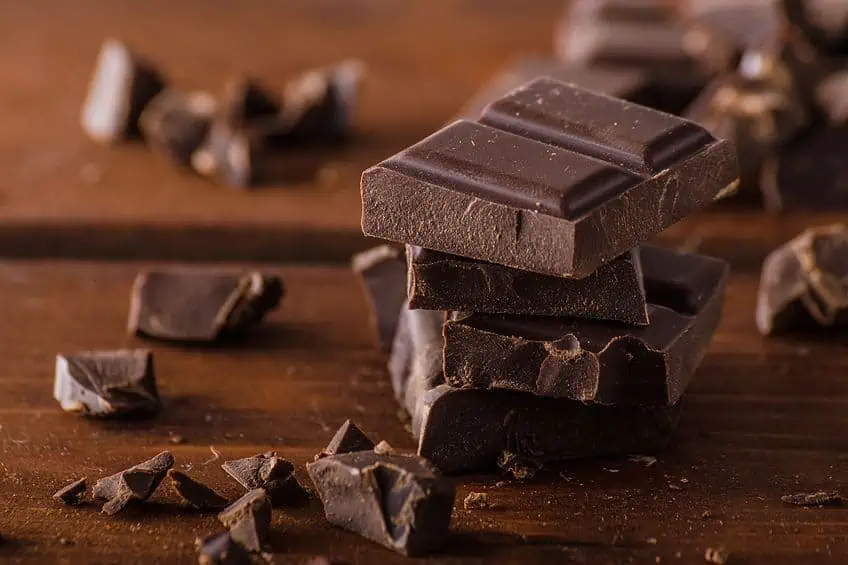
The few people who view brown as a positive color, associate it with the outdoors, trees, soil, and the earth. Brown is also multi-sensory in that its associations like wood and leather instantly bring the smell of those things to mind. The connotations with trees result in a strong and reliable feeling when looking at the color brown and also lead to feelings of security, comfort, and warmth.
| Brown Shade | Brown Hex Code | Color | Color Emotion |
| Burnt Umber | #8A3324 | Warmth, Comfort, Nostalgic | |
| Tan | #D2B48C | Happy, Content, Organized |
Black
Black, known as the absence of color is probably the strongest of all colors and can be used to imitate very extreme emotions. Black is the color of mystery, boldness, and confidence. As with most colors, because emotions are so subjective, there are positive and negative associations with this color.

Positive associations include elegance and sophistication. It is a known rule that if you don’t know what to wear to a formal event, you can’t go wrong with a black dress or black tux. Negative associations include death and evil as well as strong feelings of sadness, aggression, and fear. Negative associations with black are emphasized in the way we use black in the English language: Black magic, blackmail, blackout, black sheep, and so forth.
| Black Shade | Yellow Hex Code | Color | Color Emotion |
| Eerie Black | #1B1B1B | Scared, Uneasy | |
| Gunmetal Black | #2C3539 | Cool, In control |
White
The universal meaning of white is purity, cleanliness, and innocence. We see this during most wedding ceremonies, where brides wear the color white. Other positive connotations are freshness and simplicity. Negative associations include isolation, coldness, and emptiness.

| White Shade | White Hex Code | Color | Color Emotion |
| Ghost White | #F8F8FF | Cold, Uneasy, Chills | |
| Ivory | #FFFFF0 | Romantic, Luxury |
There are just about as many shades of color as there are emotions, and each of these relates to one another in some way. This tool can be used not only to evoke certain feelings or responses from people when perceiving artwork, buildings, interiors, and advertisements but also to alter their state of physical wellbeing. Use it wisely!
History of Color Psychology
Color psychology has a long history dating back to ancient times. Even the ancient Egyptians and Greeks used colors for healing and to influence mood.
In the 19th century, scientists such as Johann Wolfgang von Goethe and Isaac Newton began to intensively study colors and their effect on people. In 1810, Goethe wrote a book called “Zur Farbenlehre” (Theory of Colors), which made an important contribution to color psychology.
In the 1930s, Swiss psychologist Max Lüscher developed a test procedure based on colors that was used to diagnose mental disorders.
In the 1960s, companies began using color psychology for marketing and advertising to make their products more appealing and to build an emotional connection with their customers.
In recent years, color psychology has also gained importance in therapy. Colors are used in art therapy to improve the physical and mental health of patients, and also in color therapy to harmonize energy flows in the body and increase well-being.
View our Mood Colors web story here.
Frequently Asked Questions
What Color Means Happy?
Yellow is overall the most associated with the emotion of happiness. This is because it is a warm color that reminds of the sun and flowers and mostly has positive associations. Orange is a good second to yellow, as orange is closely related to playfulness which is closely linked to happiness.
What Color Is Trust?
Companies like banks ask the question of what color is trust when designing their brand, as this is one of their core values: being trustworthy. Blue is seen as a very trustworthy color. Specifically, a dark blue like navy is used in uniforms and agencies a lot to emphasize the trustworthiness of the company.
What Mood Is Purple?
Light purple colors like lavender evoke romance, bravery, and wisdom. Very dark purples can heighten negative emotions like sadness and frustration but can also increase creativity.
What Color Is the Most Emotional?
Red is a very emotional color, as it attracts a lot of attention and is associated with very strong emotions like anger, passion, and love.
What is Color Psychology?
Color psychology is a discipline that deals with the effect of colors on human behavior, mood and emotions. Colors have a strong psychological effect on us and can influence our perception and behavior.
Colors can evoke different emotions and reactions depending on cultural, personal and social factors. For example, red can trigger a strong and passionate emotion such as love or anger, while blue can be calming and relaxing.
Color psychology has applications in many fields, including marketing, advertising, design, and therapy. Companies use colors to market their brand identity and products, designers use colors to create certain moods and feelings in their work, and therapists use colors to improve the mood and well-being of their patients.
Megan is a writer and researcher who graduated from the University of Cape Town with a degree in Social Sciences, specializing in Psychology and Environmental Science. Her passion for knowledge and leaving a positive impact has fueled her current work in conscious and sustainable growth in Southern Africa. Megan’s love of nature has also led her to train as an animal behaviorist. She works part-time training and rehabilitating dogs. Megan is interested in the physical and psychological effects of colors in our environment on our mood and well-being. In addition, she is concerned with how art and creativity have been an integral part of human society. Megan van Schoor has been writing blog posts on the topics of painting, drawing, and color theory for acrylgiessen since 2021.
Learn more about Megan van Schoor and about us.
